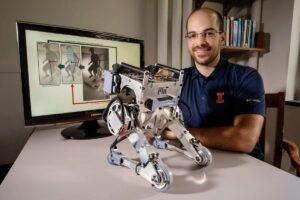
In a pioneering move that redefines the landscape of robotics, scientists at the University of Tokyo have unveiled a two-legged biohybrid robot that integrates muscle tissues with artificial materials. This innovative creation, published in the journal Matter on January 26, marks a significant advancement in the field. Shoji Takeuchi, the corresponding author, emphasizes the growing interest in biohybrid robots—a fusion of biology and mechanics—showcasing their unique potential in achieving efficient, silent movements with a soft touch.
This groundbreaking development addresses a crucial challenge faced by traditional robots—achieving the flexibility, fine movements, and energy efficiency inherent in the human body. By leveraging the power of muscle as actuators, the research team has successfully crafted a compact and nimble robot capable of walking and pivoting, pushing the boundaries of what was previously thought possible in the realm of robotic capabilities.
Biohybrid Robots: A Fusion of Biology and Mechanics
Biohybrid robots represent an exciting intersection of biological functions and mechanical ingenuity. Shoji Takeuchi highlights the appeal of this emerging field, where the marriage of biology and mechanics opens up new avenues for compact robotic designs with a unique ability to mimic human movements. The integration of muscle tissues into the robotic framework allows for a harmonious blend of biological and artificial elements, paving the way for a future generation of robots capable of performing intricate tasks with a level of finesse previously unattainable.
As researchers delve deeper into the possibilities of biohybrid robots, the latest two-legged design stands out for its innovative bipedal structure. Previous iterations excelled in linear movements but struggled with sharp turns and pivoting, limitations that this biohybrid robot aims to overcome. The focus on achieving delicate movements, inspired by human gait, signals a paradigm shift in robotics towards more nuanced and adaptable machines.

Pioneering Bipedal Design for Nimble Movements
The journey towards creating a biohybrid robot capable of nimble movements takes inspiration from the human gait, a feat that previous muscle-driven robots struggled to achieve. The team’s two-legged robot introduces an innovative bipedal design that builds on the foundation laid by its predecessors. Unlike traditional robots, this model can make sharp turns and pivot, essential features for navigating complex environments and avoiding obstacles.
To enhance the robot’s agility, researchers carefully designed a structure that mimics human gait, allowing it to walk and make fine-tuned turning motions. The combination of a foam buoy, weighted legs, and a flexible silicone rubber skeleton creates a dynamic system that operates efficiently underwater. These elements, working in tandem, enable the robot to exhibit a level of nimbleness previously unseen in biohybrid robots.
Mimicking Human Gait in Water Operation
The quest for a nimble biohybrid robot led researchers to explore the intricacies of human gait and its application in water. The decision to operate the robot underwater introduces a unique set of challenges and opportunities. Featuring a foam buoy for buoyancy and weighted legs for stability, the robot’s skeleton primarily comprises flexible silicone rubber. This design allows the robot to navigate underwater environments with precision, showcasing a level of adaptability that holds promise for various applications.
Lab-grown skeletal muscle tissues play a pivotal role in the robot’s locomotion. When electrically stimulated, these muscles contract, lifting the legs and propelling the robot forward. The coordinated activation of muscles in each leg enables the robot to walk at a speed of 5.4 mm/min. To achieve turns, the researchers employed specific electric stimulation patterns, demonstrating the robot’s ability to pivot underwater with finesse.
Electrically Stimulated Muscle Contractions for Movement Control
The intricate dance of muscle contractions orchestrated by electric stimulation governs the movement of the biohybrid robot. Each leg, equipped with lab-grown skeletal muscle tissues attached to silicone rubber, responds to electrical signals with precision. The application of electric stimulation to the muscle tissue lifts the leg, and as the electricity dissipates, the heel of the leg lands forward. By alternating electric stimulation between the left and right leg, the robot achieves a walking speed of 5.4 mm/min.
However, challenges remain in the current manual application of electric fields to each leg, a process that takes time. The team envisions a future where electrodes are seamlessly integrated into the robot, enhancing control efficiency. As the researchers work towards refining this aspect, the success of the muscle-driven bipedal robot represents a remarkable achievement in achieving controlled, nuanced movements.
Challenges and Future Prospects
While the muscle-driven bipedal robot has demonstrated success in walking, stopping, and turning motions, there are challenges on the horizon. The current manual application of electric fields to each leg, while effective, is a time-consuming process. Shoji Takeuchi envisions a more streamlined approach in the future, with electrodes integrated into the robot for more efficient control. This marks a crucial step in unlocking the full potential of biohybrid robots and expanding their capabilities beyond mere novelty.
The team’s future plans involve introducing joints and thicker muscle tissues to the bipedal robot, enabling more sophisticated and powerful movements. However, before enhancing the robot with additional biological components, the researchers must address practical considerations. Integrating a nutrient supply system is paramount to sustain living tissues, and the development of structures supporting the robot’s operation in the air is essential for expanding its versatility.
Giant Leaps Forward for Biohybrid Robots
The success of the muscle-driven bipedal robot, though seemingly small steps, represents giant leaps forward in the realm of biohybrid robots. Shoji Takeuchi’s acknowledgment of the cheer that erupted during the lab meeting underscores the significance of this achievement. As the field continues to evolve, even incremental advancements contribute to the overall progress of merging biology and robotics.
Celebrating Success and Acknowledgments
The tangible excitement within the research team as they witnessed the robot’s successful walk on video speaks volumes about the significance of their accomplishment. Shoji Takeuchi expresses gratitude for the support received from the JST-Mirai Program, JST Fusion Oriented Research for disruptive Science and Technology, and the Japan Society for the Promotion of Science. This collaborative effort has paved the way for a groundbreaking exploration into the possibilities offered by biohybrid robots, sparking enthusiasm for further advancements.
Exploring Related Topics
This groundbreaking research extends its influence into a myriad of related topics, spanning Matter & Energy, Robotics Research, Engineering, Vehicles, Computers & Math, Artificial Intelligence, Neural Interfaces, and beyond. The implications of biohybrid robots go beyond the realm of robotics, influencing diverse fields such as tissue engineering and nanorobotics. As these interdisciplinary connections grow, the potential for transformative breakthroughs in science and technology becomes increasingly evident.
Related Topics:
- Apple’s Legal Odyssey: A Deep Dive into the Blood-Oxygen Monitoring Tool Controversy – Micro2media
- Unveiling Silence: How Unspoken Concerns Impact Your Company – Micro2media
- Revolutionizing construction: The power of robotics in construction – Standard Bots
- Two-legged biohybrid robot leverages living muscle for soft, silent motions
